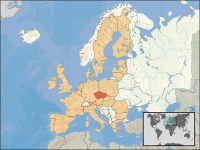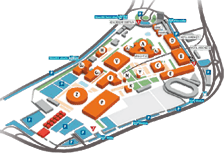Brno and the Czech Republic
 Population
Population
The Czech Republic, located in Central Europe, consists of three historical parts - Bohemia, Moravia and Silesia. It has 10, 3 million inhabitants, the official language is Czech, but around Brno, e.g., spoken Czech is slightly coloured by Moravian dialect.
Geography
Spreading over close to 79.000 square kilometres, the Czech Republic is one of the medium- size European countries. It has a boundary with Germany at the north and west, with Austria at the south, with Slovakia at the east and Poland at the northeast. That is why Czechia is often mentioned, without exaggeration, as a country within the heart of Europe.
Cities
The capital, and at the same time the largest city of the Czech Republic, is Prague. Further important cities are Brno, Ostrava, Liberec, and Plzeň. Sometimes called "Moravian Metropolis", Brno is second only to Prague, and with its 366 000 inhabitants (data received by end 2006) it is the undisputed No 1 in Moravia..
Time and weather
The Czech Republic is a continental state located in mild geographic widths of the northern hemisphere. The climate is mild and the whole country uses Central European Time (GMT + 1). The average temperature amounts to +9,4 °C (49 °F).
Recent history
Czechoslovakia was founded on October 28, 1918, and namely by the Declaration of Independence (separation from the former Austrian-Hungarian Monarchy). The democratic regime was interrupted by the outbreak of WW2. After its end Czechoslovakia, having fought at the side of the Allies, was restored. In 1948 the Communist Party usurped power in a formally legal way and held it down to 1968. On August 21, 1968 the armies of five states of the Warsaw Pact (the Soviet Union, the German Democratic Republic, Hungary, Poland and Bulgaria) invaded Czechoslovakia to punish the Czech experiment trying to reform Communism. The government that took power after the invasion of the Warsaw Pact states maintained the same until 1989. After the Velvet Revolution of 1989 a democratic government headed by President Václav Havel was re-introduced. From the beginning of 1993 the country's name is Czech Republic. (between 1989 and 1993 it was Czechoslovakia, a democratic federation of two countries: Czechia and Slovakia).
Brno
Brno lies in a broad valley at the confluence of the rivers Svratka and Svitava and its dimension from East to West makes 13 miles (22 km). Brno, known as the capital of Moravia, is favoured especially due to its infrastructure and diversified business options. It hosts a number of universities (such as Masaryk University, Mendel-University of Agriculture etc.), which converts Brno to a city of the young. People in general are friendly, open and they love guests. Moravia is known for its cheerful inhabitants - not less than for its excellent wines. The dominant of Brno is the Špilberk Castle with a palace and two chapels in the early gothic style. However, Brno is also the centre of modern architecture. One of the gems of functionalist architecture is the Brno Exhibition Centre.
Transport
Brno lies at the crossroads of the D1 (Praha - Brno) and D2 (Brno - Bratislava) motorways. Both motorways are component parts of the Trans-European West-East arteries (France - Ukraine: E50) and the Trans-European North-South axis (Scandinavia - Balkan: E55 and E65). Brno is one of the important central European railway nodes, being located at the international railway route Balkan - Budapest - Brno - Praha - Berlin - Scandinavia. Of course the trains of the Euro City network on the track Vienna - Praha make a stop here. The airport of international category lies within 7.5 km from the city centre and thanks to its very favourable climatic conditions it has the status of the first stand-by airport for Prague. The public transportation system in the city is reliable and well developed.




























